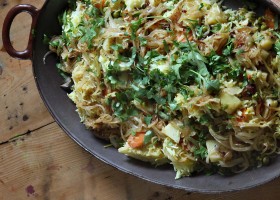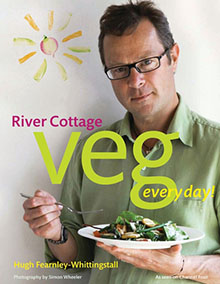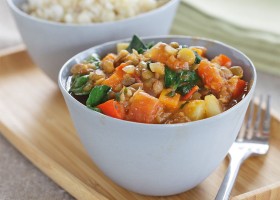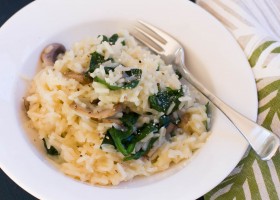Ingredients
- 5 tablespoons sunflower oil
- 1 bay leaf
- 3 cardamom pods, bashed
- 1 teaspoon cumin seeds
- 5 large onions, finely sliced
- 2 garlic cloves, crushed
- 2 teaspoons finely grated ginger
- 1 large red chilli, finely chopped (deseeded for a milder curry)
- 1 teaspoon ground cumin
- 1 teaspoon ground coriander
- ½ teaspoon ground cinnamon
- About 250g carrots, peeled and sliced into thin discs
- About 300g waxy potatoes, cut into 1–2cm cubes
- 200g peas (fresh or frozen and defrosted)
- A generous squeeze of lemon juice
- 50g sultanas
- 350g basmati rice
- A large pinch of saffron strands
- Sea salt and freshly ground
- black pepper
TO SERVE
Vegetable biryani

For a biryani, the rice and curry are first cooked separately, then together, for a final mingling of textures and flavours. You can cheat by using a biryani (medium-hot) curry powder instead of the individual spices and fresh chilli, but you’ll get a more exciting final flavour if you follow this route.
Method
Heat 2 tablespoons of the oil in a large casserole over a medium-high heat. Add the bay leaf, cardamom pods and cumin seeds and fry for a few minutes. Add 1 sliced onion and fry over a medium heat, stirring often, for about 15 minutes, till golden and soft. Lower the heat and add the garlic, ginger, chilli and ground spices. Cook, stirring, for 2 minutes.
Add the carrots, potatoes and peas and enough water to almost cover the vegetables. Bring to the boil, then reduce to a simmer. Cover and cook, stirring from time to time, for 10–15 minutes, or until the veg are al dente. Season with salt and pepper to taste and add a squeeze of lemon juice. Sprinkle the sultanas on top.
Meanwhile, rinse the rice thoroughly in several changes of water. Put into a saucepan with the saffron and a large pinch of salt. Add enough water to cover the rice by 2cm. Bring to the boil, stir once, then simmer very gently until the water is nearly all absorbed (indicated by deep steam holes on the surface). Preheat the oven to 160°C/Gas Mark 3.
Cover the rice pan with a damp tea towel and a tight-fitting lid and turn the heat as low as possible. Cook for 5 minutes. Remove the lid and use a fork to separate the rice grains.
Spoon the rice in a thick layer over the curry in the casserole. Cover the pan with a damp tea towel and put on the lid tightly. Place over a high heat for a few minutes to get the curry bubbling again, then transfer to the oven for 20 minutes. Remove and leave to stand for 10 minutes.
While the biryani is cooking, heat the remaining 3 tablespoons oil in a large frying pan over a medium-high heat and add the rest of the sliced onions. Cook briskly, stirring often, for about 20 minutes, until well browned and reduced down. Season with salt.
Uncover the biryani and scatter over the browned onions, almonds and coriander or mint. Serve with a cooling, yoghurty raita, and/or a spicy chutney.

River Cottage Veg Everyday! by Hugh Fearnley-Whittingstall, published by Bloombury, RRP $55. Click for more details
Tips and Tricks
Any leftover cooked rice can be frozen and saved for another meal. Consume within 2 weeks of freezing for maximum taste and to avoid freezer burn. If refrigerating leftovers, aim to refrigerate within 1 – 1 ½ hours after cooking to avoid bacteria multiplying in rice at room temperature.
Avoid peeling carrots – and reduce your waste – by simply scrubbing before cooking. Good scrubbing will get rid of any soil or residual dirt on your carrots and save time.
Different potato varieties have different characteristics and do best cooked in particular ways. Make sure you know which kind will best suit your purpose and buy potatoes free from sprouts green patches.







